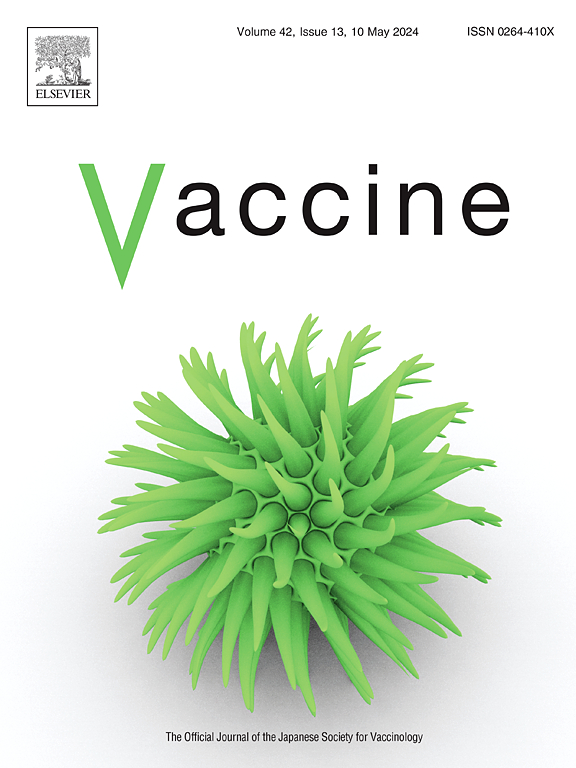Ethnic inequities in childhood influenza vaccination coverage in England 2013–2021: An observational cohort study
IF 4.5
3区 医学
Q2 IMMUNOLOGY
引用次数: 0
Abstract
Background
Children aged 2–3 years have been eligible for the seasonal influenza vaccination in primary care since its introduction into England's routine childhood immunisation schedule in 2013. Persistent ethnic inequities have been found for all other vaccines in the routine childhood immunisation schedule, so inequities in influenza vaccination coverage must also be explored to facilitate the success of the programme.
Methods
We linked mother and child primary care records using the Clinical Practice Research Datalink Aurum database (CPRD Aurum) and calculated seasonal influenza vaccination coverage in 2–3 year-olds by maternal ethnicity across England and in London between 2013 and 2021. We estimated risk ratios comparing each ethnic group to the White British group using modified Poisson regression.
Results
Influenza vaccination coverage in 2–3 year-olds is low in England (<60 % for the majority of influenza seasons) and even lower in London (<50 %). Ethnic inequities in coverage were persistent between 2013 and 2021. Most ethnic groups had lower coverage than the White British group across all influenza seasons, and children born to mothers of Caribbean ethnicity had the lowest coverage (20–27 % across seasons). Other ethnic groups including Any other Black, African or Caribbean background (25–36 %), Pakistani (26–40 %), White and Black Caribbean (28–42 %), Any other White background (30–44 %), Any other ethnic group (31–45 %) and Bangladeshi (31–41 %, except 54 % in 2020–21) also experienced low coverage. Inequities widened over time for various minority ethnic groups, including those already experiencing the lowest coverage.
Conclusions
Place-based and participatory approaches are needed to understand the drivers behind ethnic inequities in childhood influenza vaccination. Top-down and bottom-up action is also urgently needed from policy makers, commissioners, integrated care boards, primary care networks, local public health teams and healthcare staff to redress the inequities identified.
2013-2021年英格兰儿童流感疫苗接种覆盖率的种族不平等:一项观察性队列研究
背景:自2013年将季节性流感疫苗引入英格兰常规儿童免疫计划以来,2-3岁的儿童有资格在初级保健中接种季节性流感疫苗。在常规儿童免疫接种计划中,所有其他疫苗都存在持续的种族不平等现象,因此,还必须探讨流感疫苗接种覆盖率方面的不平等现象,以促进该方案的成功。方法:我们使用临床实践研究数据链Aurum数据库(CPRD Aurum)将母亲和儿童初级保健记录联系起来,并计算2013年至2021年间英格兰和伦敦按母亲种族划分的2-3岁儿童的季节性流感疫苗接种覆盖率。我们使用修正泊松回归估计了各种族与英国白人群体的风险比。结果:英格兰2-3岁儿童的流感疫苗接种率很低(结论:需要基于地方和参与性的方法来了解儿童流感疫苗接种种族不平等背后的驱动因素。决策者、专员、综合保健委员会、初级保健网络、地方公共卫生小组和保健工作人员也迫切需要采取自上而下和自下而上的行动,以纠正所发现的不平等现象。
本文章由计算机程序翻译,如有差异,请以英文原文为准。
求助全文
约1分钟内获得全文
求助全文
来源期刊

Vaccine
医学-免疫学
CiteScore
8.70
自引率
5.50%
发文量
992
审稿时长
131 days
期刊介绍:
Vaccine is unique in publishing the highest quality science across all disciplines relevant to the field of vaccinology - all original article submissions across basic and clinical research, vaccine manufacturing, history, public policy, behavioral science and ethics, social sciences, safety, and many other related areas are welcomed. The submission categories as given in the Guide for Authors indicate where we receive the most papers. Papers outside these major areas are also welcome and authors are encouraged to contact us with specific questions.
 求助内容:
求助内容: 应助结果提醒方式:
应助结果提醒方式:


